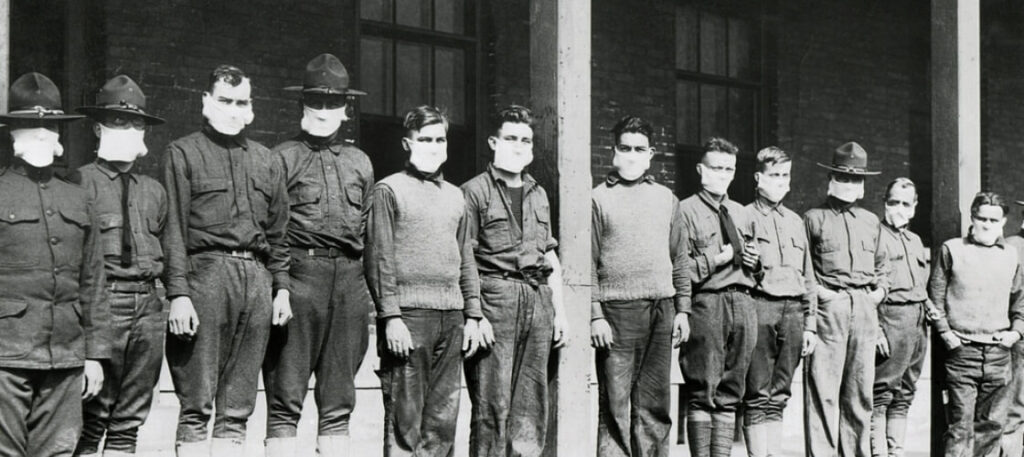The Spanish flu pandemic, which occurred in 1918-1919, was one of the deadliest pandemics in human history. It is estimated that between 50 and 100 million people died worldwide, with an estimated 675,000 deaths occurring in the United States alone1. The virus responsible for the pandemic was an H1N1 influenza virus, which is believed to have originated in birds before jumping to humans2. This article will provide an overview of the Spanish flu pandemic, including its origins, transmission, and impact on public health.
Origins of the Spanish Flu
The origins of the Spanish flu pandemic are still a matter of debate among researchers. Some scientists believe that the virus originated in China or in the United States3, while others argue that it may have emerged in France or Britain4. Regardless of its exact origins, it is believed that the virus first appeared in humans in the spring of 1918.
Spanish Flu Transmission
The Spanish flu virus was highly contagious and spread rapidly through respiratory droplets when infected individuals coughed or sneezed5. The virus could also be spread by touching contaminated surfaces and then touching one’s mouth or nose. The high rate of transmission was exacerbated by the fact that many infected individuals were asymptomatic or had only mild symptoms, allowing them to unwittingly spread the virus to others.
Spanish Flu Impact on Public Health
The Spanish flu pandemic had a profound impact on public health, both in terms of the number of deaths and the long-term effects on survivors. The virus was particularly deadly for young adults, with the highest mortality rates occurring in individuals aged 20-40 years. The high mortality rate in this age group was attributed to a phenomenon known as cytokine storm, in which the immune system overreacts to the virus, causing widespread inflammation and damage to the lungs7.
The impact of the pandemic on public health extended beyond the immediate effects on mortality rates. Survivors of the virus often experienced long-term health problems, including respiratory and neurological disorders8. In addition, the pandemic had a significant impact on the global economy, with many businesses forced to close and governments implementing social distancing measures to slow the spread of the virus9.

Conclusion
The Spanish flu pandemic was a devastating event in human history, with millions of lives lost and long-term effects on survivors. Although our understanding of the virus has improved significantly since 1918, the potential for future pandemics remains a significant public health concern. Continued research into the origins and transmission of influenza viruses, as well as the development of effective vaccines and treatments, will be critical in preparing for and responding to future pandemics.
References
- Johnson NP, Mueller J. Updating the accounts: global mortality of the 1918-1920 “Spanish” influenza pandemic. Bull Hist Med. 2002;76(1):105-15.
- Taubenberger JK, Morens DM. 1918 influenza: the mother of all pandemics. Emerg Infect Dis. 2006;12(1):15-22.
- Reid AH, Taubenberger JK. The origin of the 1918 pandemic influenza virus: a continuing enigma. J Gen Virol. 2003;84(Pt 9):2285-92.
- Oxford JS. The so-called Great Spanish Influenza Pandemic of 1918 may have originated in France in 1916. Philos Trans R Soc Lond B Biol Sci. 2001;356(1416):1857-60.
- Tellier R. Aerosol transmission of influenza A virus: a review of new studies. J R Soc Interface. 2009;6 Suppl 6:S783-90.
- Morens DM, Taubenberger JK, Fauci AS. Predominant role of bacterial pneumonia as a cause of death in pandemic influenza: implications for pandemic influenza preparedness. J Infect Dis. 2008;198(7):962-70.
- Davis LE, Caldwell GG, Lynch P, et al. Neurological aspects of the 1918 influenza pandemic: autopsy findings and interpretation. Neurology. 1998;51(4):753-8.
- Barry JM. The great influenza: the epic story of the deadliest plague in history. New York: Viking; 2004.
About Docquity
If you need more confidence and insights to boost careers in healthcare, expanding the network to other healthcare professionals to practice peer-to-peer learning might be the answer. One way to do it is by joining a social platform for healthcare professionals, such as Docquity.
Docquity is an AI-based state-of-the-art private & secure continual learning network of verified doctors, bringing you real-time knowledge from thousands of doctors worldwide. Today, Docquity has over 400,000 doctors spread across six countries in Asia. Meet experts and trusted peers across Asia where you can safely discuss clinical cases, get up-to-date insights from webinars and research journals, and earn CME/CPD credits through certified courses from Docquity Academy. All with the ease of a mobile app available on Android & iOS platforms!







